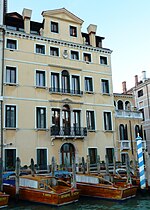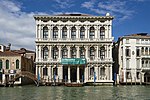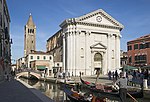Ca' Foscari

Ca' Foscari, the palace of the Foscari family, is a Gothic building on the waterfront of the Grand Canal in the Dorsoduro sestiere of Venice, Italy. It was built for the doge Francesco Foscari in 1453, and designed by the architect Bartolomeo Bon. It is now the main seat of Ca' Foscari University of Venice. The palace is located on the widest bend of the Grand Canal. Here, during the annual Regata Storica (Historical Regatta), held on the first Sunday in September, a floating wooden structure known as La Machina is placed (from this structure the Venetian authorities watch the race); this is also the site of the finishing line, and the venue for prize-giving.
Excerpt from the Wikipedia article Ca' Foscari (License: CC BY-SA 3.0, Authors, Images).Ca' Foscari
Calle Giustinian, Mestre Venezia-Murano-Burano
Geographical coordinates (GPS) Address External links Nearby Places Show on map
Geographical coordinates (GPS)
| Latitude | Longitude |
|---|---|
| N 45.434464 ° | E 12.326564 ° |
Address
Ca' Foscari
Calle Giustinian
30170 Mestre, Venezia-Murano-Burano
Veneto, Italy
Open on Google Maps










